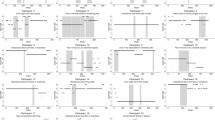Abstract
We sought to examine the evolution of postpartum anxiety, obsessions and compulsions over time, and the influence of depression on their clinical course. This was a prospective cohort of obstetric patients enrolled at a tertiary care women’s hospital. Women were recruited immediately postpartum and followed for 6 months. Women were screened for depression, state-trait anxiety, and obsessive-compulsive symptoms and dichotomized by the presence of depression. Four hundred sixty-one women agreed to participate in the study and completed the 2 weeks postpartum assessment; 331 (72 %) women completed the assessment at 6 months postpartum. At 2 weeks postpartum, 28 (19.9 %) women with depression had anxiety symptoms, compared to 4 (1.3 %) women who screened negative for depression (p < 0.001). Similarly, 36 (25.7 %) women with depression endorsed obsessions and compulsions compared to 19 (8.4 %) women without depression (p < 0.001). A significant interaction effect was present with anxiety over time such that by 6 months postpartum, there were no differences in symptoms in women with and without depression (p = 0.860). Conversely, the differences in obsessions and compulsions between depressed and non-depressed women persisted (p = 0.017). Women with postpartum depression are more likely to experience comorbid state-trait anxiety and obsessive-compulsive symptoms in the immediate postpartum period. While state-trait anxiety symptoms tend to resolve with time, obsessive-compulsive symptoms persist. Understanding these temporal trends is critical to tailor appropriate monitoring and treatment.

Similar content being viewed by others
References
Abramowitz JS, Meltzer-Brody S, Leserman J, Killenberg S, Rinaldi K, Mahaffey BL, Pedersen C (2010) Obsessional thoughts and compulsive behaviors in a sample of women with postpartum mood symptoms. Arch Womens Ment Health 13:523–530
American Psychiatric Association (2000) Practice guideline for the treatment of patients with major depressive disorder (revision). Am J Psychiatry 157:1–45
American Psychiatric Association (2013) Diagnostic and statistical manual of mental disorders, 5th edn. American Psychiatric Publishing, Arlington
Austin MP, Hadzi-Pavlovic D, Priest SR, Reilly N, Wilheim K, Saint K, Parker G (2010) Depressive and anxiety disorders in the postpartum period: how prevalent are they and can we improve their detection? Arch Womens Ment Health 13:395–401
Challacombe FL, Salkovskis PM (2011) Intensive cognitive-behavioural treatment for women with postnatal obsessive-compulsive disorder: a consecutive case series. Behav Res Ther 49:422–426
Hudak R, Wisner KL (2012) Diagnosis and treatment of postpartum obsessions and compulsions that involve infant harm. Am J Psychiatr 169:360–363
Kendler KS, Neale MC, Kessler RC, Heath AC, Eaves LJ (1992) Major depression and generalized anxiety disorder. Same genes, (partly) different environments? Arch Gen Psychiatry 49:716–722
Kessler RC, Nelson CB, McGonagle KA, Liu J, Swartz M, Blazer DG (1996) Comorbidity of DSM-III-R major depressive disorder in the general population: results from the US National Comorbidity Survey. Br J Psychiatry Suppl 30:17–30
Kroenke K, Spitzer RL, Williams JB (2001) The PHQ-9: validity of a brief depression severity measure. J Gen Intern Med 16:606–613
Mauri M, Oppo A, Montagnani MS, Borri C, Banti S, Camilleri V, Cortopassi S, Ramacciotti D, Rambelli C, Cassano GB (2010) Beyond “postpartum depressions”: specific anxiety diagnoses during pregnancy predict different outcomes: results from PND-ReScU. J Affect Disord 127:177–184
Meades R, Ayers S (2011) Anxiety measures validated in perinatal populations: a systematic review. J Affect Disord 133:1–15
Miller ES, Chu C, Gollan J, Gossett DR (2013) Obsessive-compulsive symptoms during the postpartum period. A prospective cohort. J Reprod Med 58:115–122
Pine DS (2009) Integrating research on development and fear learning: a vision for clinical neuroscience? Depress Anxiety 26:775–779
Prenoveau J, Craske M, Counsell N, West V, Davies B, Cooper P, Rapa E, Stein A (2013) Postpartum GAD is a risk factor for postpartum MDD: the course and longitudinal relationships of postpartum GAD and MDD. Depress Anxiety 30:506–514
Rosenfeld R, Dar R, Anderson D (1992) A computer-administered version of the Yale-Brown Obsessive-Compulsive Scale. Psychol Assess 4:329–332
Skouteris H, Wertheim EH, Rallis S, Milgrom J, Paxton SJ (2009) Depression and anxiety through pregnancy and the early postpartum: an examination of prospective relationships. J Affect Disord 113:303–308
Spitzer RL, Kronke K, Williams JB (1999) Validation and utlity of a self-report version of PRIME_MD: the PHQ primary care study. Primary Care Evaluation of Mental Disorders. Patient Health Questionnaire. JAMA 282:1737–1744
Wenzel A, Haugen EN, Jackson LC, Brendle JR (2005) Anxiety symptoms and disorders at eight weeks postpartum. J Anxiety Disord 19:295–311
Wisner KL, Peindl KS, Gigliotti T, Hanusa BH (1999) Obsessions and compulsions in women with postpartum depression. J Clin Psychiatry 60:176–180
Wisner KL, Sit DK, McShea MC, Rizzo DM, Zoretich RA, Hughes CL, Eng HF, Luther JF, Wisniewski SR, Costantino ML, Confer AL, Moses-Kolko EL, Famy CS, Hanusa BH (2013) Onset timing, thoughts of self-harm, and diagnoses in postpartum women with screen-positive depression findings. JAMA Psychiatry 70:490–498
Conflict of interest
The authors declare that they have no conflict of interest.
Author information
Authors and Affiliations
Corresponding author
Rights and permissions
About this article
Cite this article
Miller, E.S., Hoxha, D., Wisner, K.L. et al. The impact of perinatal depression on the evolution of anxiety and obsessive-compulsive symptoms. Arch Womens Ment Health 18, 457–461 (2015). https://doi.org/10.1007/s00737-014-0476-x
Received:
Accepted:
Published:
Issue Date:
DOI: https://doi.org/10.1007/s00737-014-0476-x




